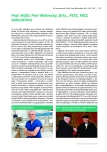Operation of Ebstein anomaly in adulthood – our experience
Authors:
Jana Popelová 1,2; Roman Gebauer 1,2; Petr Pavel 1; Štěpán Černý 1; Pavel Jehlička 1; Petr Plášil 1; Ivo Skalsky 1
Authors‘ workplace:
Centrum pro diagnostiku a léčbu vrozených srdečních vad u dospělých, vedoucí lékařka doc. MUDr. Jana Popelová, CSc., Kardiochirurgického oddělení Nemocnice Na Homolce Praha, přednosta prim. MUDr. Ivo Skalský, MBA
1; Dětské kardiocentrum FN Motol Praha, přednosta a prim. prof. MUDr. Jan Janoušek, Ph. D.
2
Published in:
Vnitř Lék 2014; 60(4): 335-340
Category:
60th Birthday - prof. MUDr. Petr Widimský, DrSc., FESC, FACC
Overview
Introduction:
The outcome of the operation of the Ebstein anomaly in adulthood depends on the experience of the surgical team.
Methods and results:
We operated 38 adult patients with Ebstein anomaly at the age of 34.8 ± 12.7 (19–63) years at the Department of Cardiac Surgery, Hospital Na Homolce, Prague, in the period of 2005–2013. The majority of patients (71 %) had Ebstein anomaly type C or D. The 30-days postoperative mortality was 5.2 %. In the long-term follow-up 2 other patients died. Tricuspid valve repair was performed in 45 %, bioprosthesis was implanted in 53 %. Concomitant bi-directional cavo-pulmonary anastomosis was performed in 31.5 %, mitral valve repair in 8 %, closure of atrial communication in 83 %, right-sided MAZE or istmus cryo-ablation in 39 %. After the operation we found improvement of the functional NYHA class (from 2.2 ± 0.7 to 1.7 ± 0.6; p < 0.0001) as well as decrease of tricuspid regurgitation (from grade 3.8 ± 0.4 to 0.9 ± 1; p < 0.0001). The ejection fraction of the right ventricle (RVEF) improved in 86 % of patients, in 14 % RVEF decreased or did not change (RVEF before operation 36 ± 10.5 %, after operation 42 ± 9.5 %, p = 0.001). In the long-term follow-up we found dysfunction of the tricuspid valve repair in 12 % and degeneration of the bioprosthesis in 15 %. Among 86 adult patients with Ebstein anomaly from our database the mortality was significantly higher in unoperated compared to operated patients (26 % vs 12 %, p = 0.006). Patients with cyanosis had high mortality regardless of surgery (40 % with and 83 % without operation). Reoperation after surgery in childhood or adulthood was necessary in 20 % of adults.
Conclusion:
The adult patients with Ebstein anomaly should be examined in a specialized center even if the symptoms are mild. The operation should be performed by a team with good results and experience in surgery and post-operative care in Ebstein anomaly. According to our knowledge Hospital Na Homolce represents such specialized center for Czech Republic.
Key words:
bidirectional cavo-pulmonary anastomosis – cyanosis – Ebstein anomaly of the tricuspid valve – tricuspid valve repair – operation of adults with congenital heart disease
Sources
1. Ebstein W. Uber einen sehr seltenen Fall von Insuffizient der Valvula tricuspidalis, bedingt durch eine angeborene hochgradige Missbildung derselben. Arch Anat Physiol Wissensch Med 1866; 33 : 238–254.
2. Carpentier A, Chauvaud S, Mace L et al. A new reconstructive operation for Ebstein anomaly of the tricuspid valve. J Thorac Cardiovasc Surg 1988; 96(1): 92–101.
3. Celemajer DS, Cullen S, Sullivan ID et al. Outcome in neonates with Ebstein´s anomaly. J Am Coll Cardiol 1992; 19(5): 1041–1046.
4. Šamánek M, Voříšková M. Congenital heart disease among 815,569 children born between 1980 and 1990 and their 15-year survival: A prospective Bohemia survival study. Pediatr Cardiol 1999; 20(6): 411–417.
5. Popelová J. Vrozené srdeční vady v dospělosti. Grada: Praha 2003, 221–235. ISBN 80–247–0451-X.
6. Krupičková S, Chaloupecký V, Tláskal T et al. Výsledky chirurgické léčby Ebsteinovy anomálie trikuspidální chlopně. Cor et Vasa 2009; 51(7–8): 500–505.
7. Brown ML, Dearani JA, Danielson GK et al. Functional Status After Operation for Ebstein anomaly: the Mayo Clinic Experience. J Am Coll Cardiol 2008; 52(6): 460–466.
8. Brown ML, Dearani JA, Danielson GK et al. The outcomes of operations for 539 patients with Ebstein anomaly. J Thorac Cardiovasc Surg 2008; 135(5): 1120–1136.
9. Sarris GE, Giannopoulos NM, Tsoutsinos AJ et al. Results of surgery for Ebstein’s anomaly: a multicenter study from the European Congenital Heart Surgeons Association. J Thorac Cardiovasc Surg 2006; 132(1): 50–57.
10. Chauvaud S, Berrebi A, d´Attelis N et al. Ebstein´s anomaly: repair based on functional analysis. Eur J Cardiothorac Surg 2003; 23(4): 525–531.
11. Gebauer R, Černý Š, Pavel P et al. Korekce Ebsteinovy anomálie u dospělých pacientů. Cor et Vasa 2009; 51(1): 19–23.
12. Vahanian A, Alfieri O, Andreotti F et al. Guidelines on the management of valvular heart disease (version 2012). Eur Heart J 2012; 33(19): 2451–2496.
13. Zoghbi WA, Enriquez-Sarano M, Foster E et al. Recommendations for Evaluation of the Severity of Native Valvular Regurgitation with Two-dimensional and Doppler Echocardiography. J Am Soc Echocardiogr 2003; 16(7): 777–802.
14. Popelová J, Brtko M, Němec P. Summary of the ESC guidelines on the management of valvular heart disease (version 2012). Cor et Vasa 2013; 55(1): e41-e56.
15. Baumgartner H, Bonhoeffer P, De Groot NMS et al. ESC Guidelines for the management of grown-up congenital heart disease (new version 2010). European Heart Journal 2010; 31(23): 2915–2957.
Labels
Diabetology Endocrinology Internal medicineArticle was published in
Internal Medicine

2014 Issue 4
Most read in this issue
- Liver in heart failure
- Right ventricle in severe pulmonary hypertension in congenital heart defects – different and specific.
- Operation of Ebstein anomaly in adulthood – our experience
- Mitral stenosis
